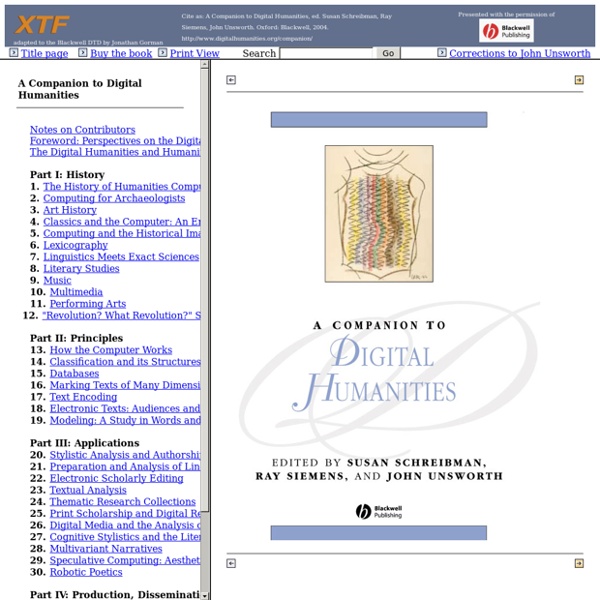



Digital Humanities Now » Getting Started in Digital Humanities Journal of Digital Humanities Lisa Spiro When I presented at the Great Lakes College Association’s New Directions workshop on digital humanities (DH) in October, I tried to answer the question “Why digital humanities?” But I discovered that an equally important question is “How do you do digital humanities?” Although participants seemed to be excited about the potential of digital humanities, some weren’t sure how to get started and where to go for support and training. Building on the slides I presented at the workshop, I’d like to offer some ideas for how a newcomer might get acquainted with the community and dive into digital humanities work. Determine what goals or questions motivate you As with any project, a research question, intellectual passion, or pedagogical goal should drive your work. Get acquainted with digital humanities Participate in the digital humanities community Attend a THATCamp. Stay informed Explore examples for inspiration and models To find projects, see, for example, Pursue training.
Digital humanities The Digital Humanities are an area of research, teaching, and creation concerned with the intersection of computing and the disciplines of the humanities. Developing from the fields of humanities computing, humanistic computing,[2] and digital humanities praxis (dh praxis[3]) digital humanities embrace a variety of topics, from curating online collections to data mining large cultural data sets. Digital humanities (often abbreviated DH) currently incorporate both digitized and born-digital materials and combine the methodologies from traditional humanities disciplines (such as history, philosophy, linguistics, literature, art, archaeology, music, and cultural studies) and social sciences [4] with tools provided by computing (such as data visualisation, information retrieval, data mining, statistics, text mining) and digital publishing. Objectives[edit] A growing number of researchers in digital humanities are using computational methods for the analysis of large cultural data sets.
Humanidades Digitais | Grupo de Pesquisas | Universidade de São Paulo Tooling Up for Digital Humanities Manifeste des Digital humanities | ThatCamp Paris Contexte Nous, acteurs ou observateurs des digital humanities (humanités numériques) nous sommes réunis à Paris lors du THATCamp des 18 et 19 mai 2010. Au cours de ces deux journées, nous avons discuté, échangé, réfléchi ensemble à ce que sont les digital humanities et tenté d’imaginer et d’inventer ce qu’elles pourraient devenir. À l’issue de ces deux jours qui ne sont qu’une étape, nous proposons aux communautés de recherche et à tous ceux qui participent à la création, à l’édition, à la valorisation ou à la conservation des savoirs un manifeste des digital humanities. I. Définition 1. 2. 3. II. 4. – que se sont multipliées les expérimentations dans le domaine du numérique en Sciences humaines et sociales depuis un demi-siècle. – que le numérique induit une présence plus forte des contraintes techniques et donc économiques dans la recherche ; que cette contrainte est une opportunité pour faire évoluer le travail collectif ; III. 5. 6. 7. 8. IV. 9. 10. 11. 12. 13. 14. Rejoignez-nous !
What is the Spatial Turn? · Spatial Humanities What is a turn? Humanities scholars speak of a quantitative turn in history in the 1960s, a linguistic and cultural turn of the 1980s in history and literature, and even more recently an animal turn. Beyond the academy, to turn implies retrospection, a process of stopping in the road and glancing backwards at the way by which one has come. May the weary traveler turn from life's dusty road and in the wayside shade, out of this clear, cool fountain drink, and rest “Landscape turns” and “spatial turns” are referred to throughout the academic disciplines, often with reference to GIS and the neogeography revolution that puts mapping within the grasp of every high-school student. This essay documents the contributions of the university disciplines in the period from 1880 to 1960, a moment supremely fertile for academic discourse, when scholars in history, religion, and psychology reflected on our nature as beings situated in space.
About » THATCamp Theory 2012 For more information about THATCamp in general, see the central THATCamp website at thatcamp.org and/or write the central THATCamp Coordinator at info@thatcamp.org. What is a THATCamp? THATCamp stands for “The Humanities and Technology Camp.” It’s collaborative: there are no spectators at a THATCamp. What is THATCamp Theory? Wikipedia defines Critical Theory as an examination and critique of society and culture, drawing from knowledge across the social sciences and humanities. Many people think that critical theory is a discourse that is practiced only in the ivory tower. THATCamp Theory is many things to many people, but we are inspired by two separate ideas. Just this week I was presenting The Early American Foreign Service Database and got the question “So where is the theory in all of this?” What might it mean to do “real theoretical work” as a database? Second, the Situationist International believed that in order to fully critique culture they needed to hack art and literature.